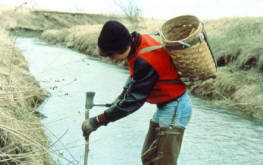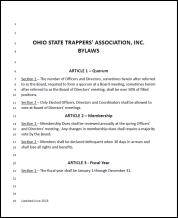


OSTA CALENDAR








OSTA Hall of Fame



Copyright©2011-2024 OSTA, Inc.
All Rights Reserved
Website by Hawk Mountain Designs
OSTA President's Award
Muskrat Study Report
in terms of (1) presence of disease, (2) accumulation of toxins, and (3) detrimental effects of contaminants. Sex and age structure, as well as reproductive output were also determined for the sample population. Trappers across Ohio donated legally trapped muskrats for this study. A total of 592 muskrats from the 2013-14 and 2014-15 trapping seasons from across the state were necropsied. Click to Read Complete Study
• The overall declines in regional population trends for muskrats are alarming. As such, the Ohio Division of Wildlife, working in cooperation with the Ohio State Trappers Association and the Wilds, launched an ambitious project to methodically examine potential factors that could be contributing to the muskrat decline.
• Objectives of this study were to collect muskrat carcasses from across Ohio to
determine health in terms of (1) presence of disease, (2) accumulation of toxins, and (3) detrimental effects of contaminants. Sex and age structure, as well as reproductive output were also determined for the sample population.
• Trappers across Ohio donated legally trapped muskrats for this study. A total of 592 muskrats from the 2013-14 and 2014-15 trapping seasons from across the state were necropsied.
• Based on molar indices, approximately 11% of the samples were adults. All adult
females had reproduced, having 1–3 litters/year with an average placental scar count of 15.0 ± 6.1 (range 3 – 32). Sex ratio was 1.1 males for every 1.0 female. These values are typical for muskrats at Ohio’s latitude.
• Few abnormalities of carcasses were noted during necropsy. White lesions noted on the livers of six muskrats were diagnosed as strobilocercus, which are bladder-like cystic structures formed by taenioid tapeworm larva. These likely had little effect on the population.
• Pesticides and personal care products appeared to play a minor role in muskrat
toxicology based on observed exposure.
• Nineteen of the 23 tested elements, however, occurred above threshold values.
• Forty muskrats of the 41 adults tested exhibited exposure above threshold limits for 1 to 18 metals.
• Less than 25% of the individuals (n = 9 of 41) were exposed to aluminum, arsenic,
boron, chromium, cobalt, copper, cadmium, lead, nickel, selenium, silver, vanadium, or zinc.
• Three muskrats from widely separated areas, Ashland, Fayette, and Guernsey counties, exhibited exposure to 18, 17, and 18, of the 23 metals for which we tested, respectively.
• The exposure to 6 metals was more widespread and consequently has the potential to cause detrimental effects on a large scale. These were antimony (n = 19 muskrats), calcium (n = 19), iron (n = 21), mercury (n = 21), molybdenum (n = 19), and strontium (n = 22).
• Muskrats in areas across Ohio suffered from moderate to severe levels of metal
contamination. Such contamination can have negative effects on health, survival, and
reproduction. However, the pathogenic effects of contaminants cannot be known without additional testing. Histological tests on major organ tissues are needed to determine if and to what extent contamination with metals is impacting muskrat populations in Ohio.
• Nonetheless, knowledge concerning the level of exposure to toxic metals in Ohio’s
muskrats represents a significant beginning in our effort to determine factors contributing to muskrat decline.



Nomination Form
Nominations are being accepted for OSTA Hall of Fame and Lifetime Achievement awards.
Induction into the OSTA Hall of Fame is the highest honor that can be bestowed upon those who have given of themselves to help preserve the heritage of trapping - a memorial for all time.
The Lifetime Achievement award is given to a person who has devoted themselves to protecting trapping in many ways for a number of years.
If you know of someone who meets this criteria, download the attached form and submit to an awards committee member.
NOMINATION APPLICATION
2024
Carl Jones
2021-2023
No Inductees
2020
Keith Daniels
Karen and Dave Linkhart
2019
No Inductees
2018
No Inductees
2017
Eric Ucker
2016
No Inductees
2015
Bob and Lenore Landis
Kim Martin
Jerry Thomas
Frank Pike
William Schlafly
Glenn Wilson Jr.
2014
Dan Hill
Mark Stackhouse
2013
No Inductees
2012
No Inductees
2011
Tom Parr
Jon & Phyllis Hughes
Mike & Patti Conrad
Bob & Shirley Fissell
2010
Ruth Gram
John Vargo
Doug Haubert
2009
Bob Best
Sheldon Colvin
JC & Mary Ann Conner
Jerry & Ann Cooper
Clyde Pidcock
Tom Pike
Ed Richards
2008 (First Year)
Art Scott
Charles Dobbins (D)
Keith Landies
Hal Sullivan
Denver Hill
Lester Fitzgerald
Russ Collar
OSTA Lifetime Achievement Award

2022
Jon Hughes
2021
Tim & Peggy Ackerman
2020
Greg Wasilewski
2019
Frank “Connie” Grauer
2018
Wayne & Gloria Mott
Keith Daniels
2017
Dirk Shearer
Dave Pitstick
Menno Yoder
2016
Ken Stewart (PDK Snares)
Jeff Robinson (JR & Sons)
2015
Keith Winkler (Sterling Fur)
John Epler (Epler Furs)
Don Duro (Duro Enterprises)
Joe Goodman (Goodman Prints)
2014
Ed Molnar
Carroll Black
Dave & Karen Linkhart
2013
Keith Jones
2012
Ted Arters
2011
Corky Klausing
2010
Harry Kennison
2009
D. Kim Martin
Matt Vedrin
Don Holmes
2008
Bob Bucher
2007
Harold Weismiller
2006
Rich Butera
2005
Russ Collar
2004
Denver Hill
2003
D. Kim Martin
2002
Hal Sullivan
2001
Lester Fitzgerald
2000
Art Scott
1999
Jeff Kirn (F-F-G)
1998 (1st Year for LAA)
Rex Inbody
2024
No Nominations
2023
Tim Ackerman
Mike Bruns
Paul & Joyce Moeller
Dave Muir
Scott Muir
Richard New
Joe Spicer
2022
Ken Stewart
Joe Young
Keith & Tina Jones
Bill & Chris Davis
2021
Keith Daniels
2020
Ken Stewart
Sara O’Banion
2019
Doug Lee
2018
No Nominations
2017
Steve Bourgeois
Dean & Ray Eaton
2016
Steve Hiller
2015
Mike Conrad
2014
Richard Neu
2013
Tim & Peggy Ackerman
2012
No Nominations
2011
Keith Daniels
2010
Nancy & Mark Basinger
2009
Don Smith
2008
Carl Jones
2007
Shirley & Bob Fissell
2006
Doug Haubert
2005
Mike Conrad
2004
Steve Massie
2003
Jon & Phyllis Hughes
2002
Ron Reinhart
2001
Rex Adams
2000
Larry Williams
1999
Jerry Heimbrock
1998
Chris Prickett
1997
No Nominations
1996
Keith Daniels
1994-95
No Nominations
1993
Bob Best
1992
No Nominations
1991
Keith Landies
1989-90
No Nominations
1987
Bob Landis
1986
Charles Dobbins
Art Scott
1985
Ruth Gram
OSTA Constitution & Bylaws
October: Region A Meet - CANCELED
October 11: Region B Meet, Holmesville, OH
October 25: Region C Meet, Washington CH
October 25-26: OSTA Trapping Workshops

